For left-handed guitar players, the struggle is real. Throughout history, lefties have faced challenges in a world designed for right-handed individuals. From everyday objects to musical instruments, options have often been limited. While the music world is slowly catching up, finding the perfect left-handed acoustic guitar can still feel like searching for a needle in a haystack. You might stumble upon an incredible sounding acoustic guitar, only to realize it’s built for a right-handed player. But don’t despair! Converting a right-handed acoustic guitar to left-handed is a viable solution, allowing you to play the instrument of your dreams. It’s more than just restringing; it’s a delicate process requiring skill and precision. Let’s dive into how a right-handed acoustic guitar can be transformed into a comfortable and playable Acoustic Guitar Left-handed model.
Why Consider a Left-Handed Conversion?
Before we get into the “how,” let’s quickly touch upon the “why.” Left-handed guitars were once scarce, leading legendary players like Jimi Hendrix to adapt right-handed guitars. While more left-handed models are available now, the selection is still dwarfed by right-handed options. Sometimes, a specific guitar with unique tonal qualities or vintage appeal might only be available in a right-handed configuration. Instead of compromising on your dream instrument, conversion opens up a wider range of possibilities. If you’ve found “the one” but it’s designed for a righty, a professional conversion can make it yours without sacrificing playability or sound.
The Acoustic Guitar Left Conversion Process: A Step-by-Step Guide
Converting an acoustic guitar to left-handed primarily involves adjustments to the bridge saddle and nut. These components are crucial for proper intonation and string alignment, both of which are affected when switching the guitar’s orientation. Here’s a breakdown of the process:
Addressing the Bridge Saddle
The bridge saddle on an acoustic guitar isn’t straight; it’s angled. This angle is intentional, designed to compensate for the different thicknesses (gauges) of the guitar strings. This compensation is vital for accurate intonation – ensuring the guitar plays in tune across the fretboard. If you were to simply reverse the strings on a right-handed saddle, the intonation would be severely off, with lower strings sounding sharp and higher strings flat.
Here’s a look at a typical right-handed bridge saddle before conversion:
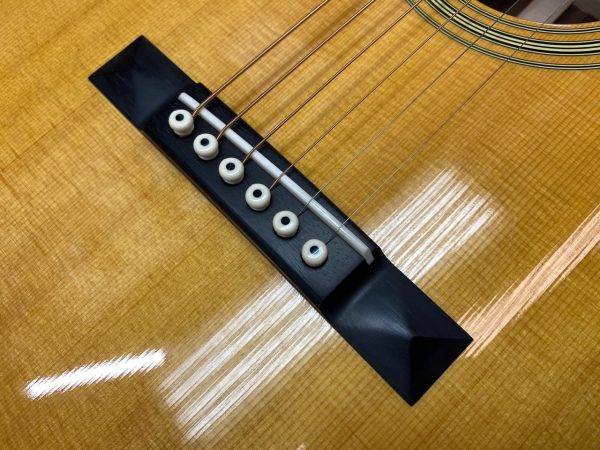 Right-handed acoustic guitar bridge with angled saddle for intonation compensation
Right-handed acoustic guitar bridge with angled saddle for intonation compensation
The first step in the conversion is to address this angled saddle slot. To create a new, left-handed saddle slot, the original slot needs to be filled. Typically, a piece of wood that matches the bridge material, like ebony, is carefully shaped to fit the existing slot.
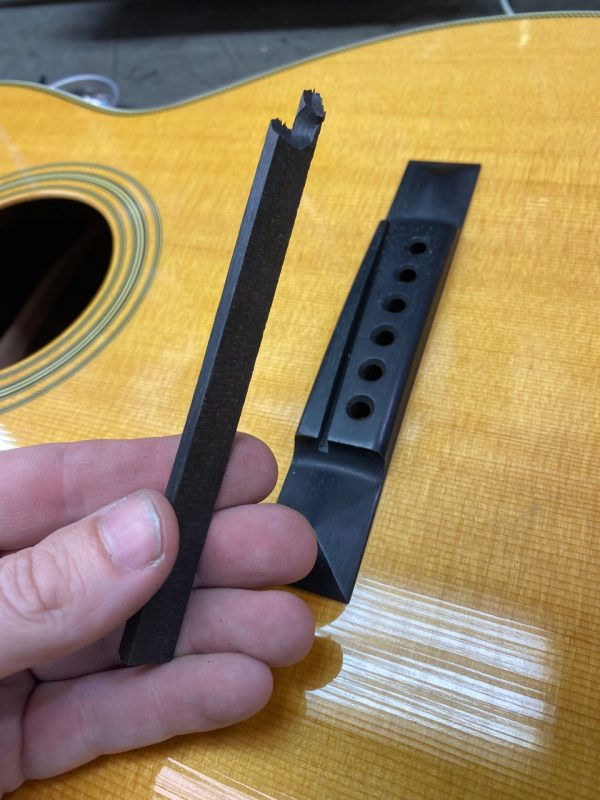 Ebony being glued into the original saddle slot of a right-handed acoustic guitar bridge during conversion to left-handed
Ebony being glued into the original saddle slot of a right-handed acoustic guitar bridge during conversion to left-handed
This ebony piece is then glued into place, and meticulously carved and sanded down to seamlessly blend with the bridge, creating a smooth, uniform surface ready for the new saddle slot.
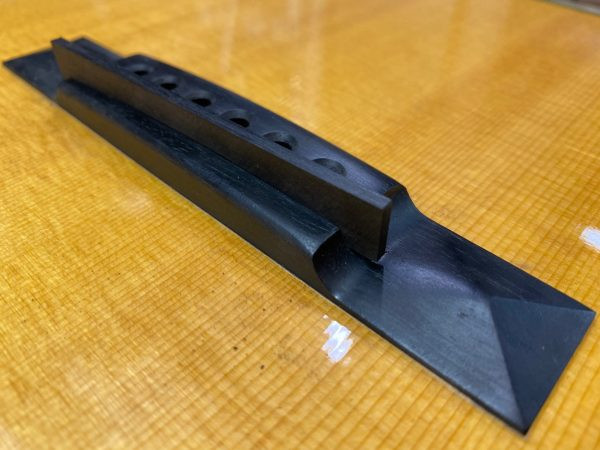 Close-up of the ebony filling seamlessly integrated into the acoustic guitar bridge
Close-up of the ebony filling seamlessly integrated into the acoustic guitar bridge
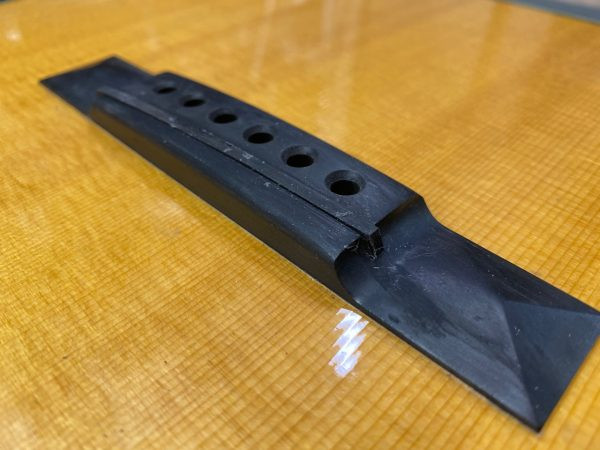 Sanded and smoothed ebony filling, preparing the bridge for a new left-handed saddle slot
Sanded and smoothed ebony filling, preparing the bridge for a new left-handed saddle slot
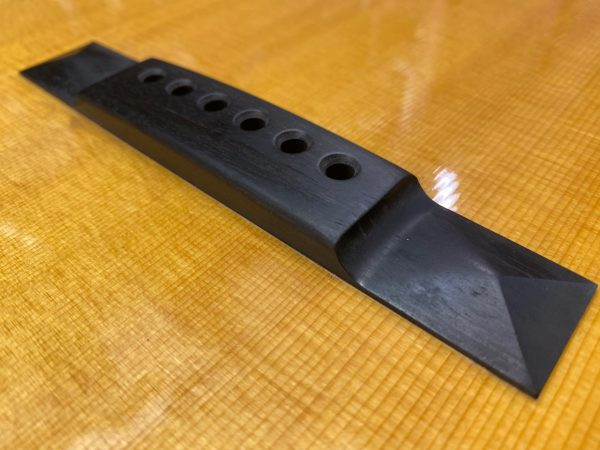 Bridge surface leveled and ready for precise cutting of the left-handed saddle slot
Bridge surface leveled and ready for precise cutting of the left-handed saddle slot
Cutting the New Left-Handed Saddle Slot
Creating the new saddle slot is the most crucial and delicate part of the conversion. The position and angle of this new slot are paramount for accurate intonation. Precision is key here. While traditional methods rely on intricate jigs and manual skill, modern techniques can enhance accuracy. Tools like the PLEK machine, a computerized fret leveling and setup system, can be employed to cut the new slot with exceptional precision.
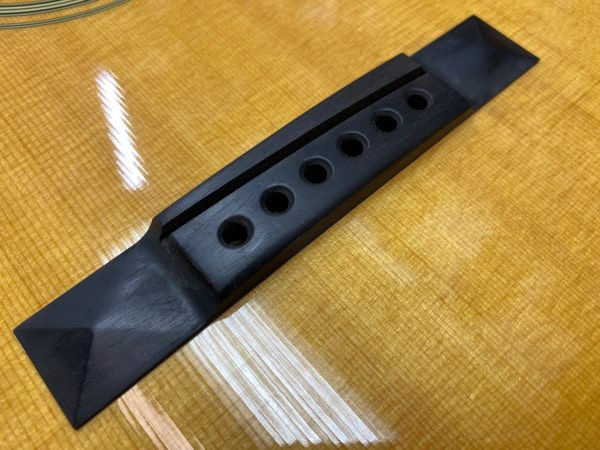 Perfectly cut left-handed saddle slot in an acoustic guitar bridge using a PLEK machine for accurate intonation
Perfectly cut left-handed saddle slot in an acoustic guitar bridge using a PLEK machine for accurate intonation
The PLEK machine allows for incredibly precise placement and angling of the saddle slot, ensuring optimal intonation for the converted acoustic guitar left-handed setup. The result is a clean, perfectly positioned slot that looks as if it was originally designed for a left-handed guitar.
Crafting a New Nut and Saddle
Beyond the saddle slot, the nut – the slotted piece at the headstock that guides the strings – also needs to be replaced. A right-handed nut is cut for right-handed string spacing and gauges. For a left-handed conversion, a new nut with reversed string spacing is essential. Similarly, a new saddle, custom-shaped for the left-handed string setup, is crafted. Bone is a preferred material for nuts and saddles due to its tonal properties and durability. These components are often handcrafted, blending technical skill with artistry.
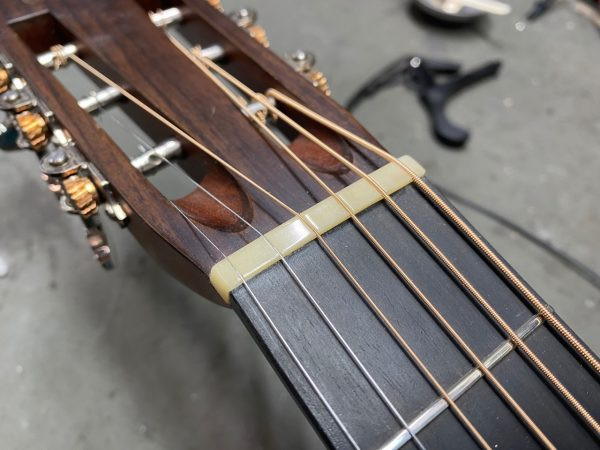 Hand-crafted bone nut and saddle for a left-handed acoustic guitar conversion, showcasing artisan guitar tech skills
Hand-crafted bone nut and saddle for a left-handed acoustic guitar conversion, showcasing artisan guitar tech skills
The creation of a new nut and saddle ensures proper string height, spacing, and overall playability for the left-handed guitarist.
Adding Side Dots
Finally, for ease of playing, side dots – the fret markers on the side of the neck – are added to the opposite side of the fretboard. This is a practical addition to aid left-handed players in navigating the fretboard visually.
Final Setup
The conversion process culminates in a complete guitar setup. This includes fret leveling (often done with the PLEK for accuracy), adjusting the action (string height), and ensuring optimal playability. The result is a fully functional, comfortable, and intonation-accurate acoustic guitar left-handed instrument.
Conclusion: Opening Doors for Left-Handed Players
Converting a right-handed acoustic guitar to left-handed is more than just a string reversal; it’s a detailed process that requires expertise and attention to detail. However, it opens up a world of possibilities for left-handed players, allowing them to access a broader range of instruments and find their perfect sound. If you’re a lefty who’s found a right-handed acoustic guitar you love, don’t let handedness be a barrier. With a professional conversion, you can transform it into your dream acoustic guitar left-handed companion and enjoy playing without compromise.
